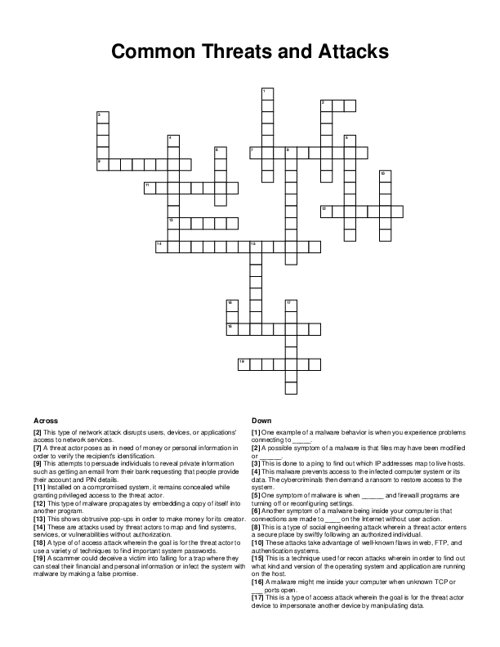Common Threats and Attacks Crossword Puzzle
Download and print this Common Threats and Attacks crossword puzzle.
Related puzzles:
Browse all Safety / Prevention Puzzles
QUESTIONS LIST:
- viruses: this type of malware propagates by embedding a copy of itself into another program.
- ransomware: this malware prevents access to the infected computer system or its data. the cybercriminals then demand a ransom to restore access to the system.
- rootkits: installed on a compromised system, it remains concealed while granting privileged access to the threat actor.
- phishing: this attempts to persuade individuals to reveal private information such as getting an email from their bank requesting that people provide their account and pin details.
- adware: this shows obtrusive pop-ups in order to make money for its creator.
- reconnaissance: these are attacks used by threat actors to map and find systems, services, or vulnerabilities without authorization.
- dos: this type of network attack disrupts users, devices, or applications' access to network services.
- access: these attacks take advantage of well-known flaws in web, ftp, and authentication systems.
- scanners: this is a technique used for recon attacks wherein in order to find out what kind and version of the operating system and application are running on the host.
- sweep: this is done to a ping to find out which ip addresses map to live hosts.
- deleted: a possible symptom of a malware is that files may have been modified or _ .
- networks: one example of a malware behavior is when you experience problems connecting to _ .
- antivirus: one symptom of malware is when _ and firewall programs are turning off or reconfiguring settings.
- udp: a malware might me inside your computer when unknown tcp or _ ports open.
- hosts: another symptom of a malware being inside your computer is that connections are made to _ on the internet without user action.
- password: a type of of access attack wherein the goal is for the threat actor to use a variety of techniques to find important system passwords.
- spoofing: this is a type of access attack wherein the goal is for the threat actor device to impersonate another device by manipulating data.
- tailgating: this is a type of social engineering attack wherein a threat actor enters a secure place by swiftly following an authorized individual.
- pretexting: a threat actor poses as in need of money or personal information in order to verify the recipient's identification.
- baiting: a scammer could deceive a victim into falling for a trap where they can steal their financial and personal information or infect the system with malware by making a false promise.





